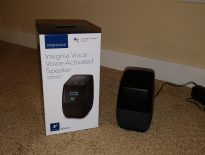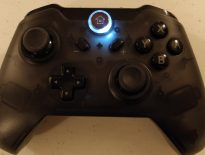Editor’s Note: This article was updated 1/13/2019 to reflect new information.
Looking for an inexpensive alternative to Philips Hue or LIFX smart bulbs? Read on to find out if the Geeni Prisma 1050 Multicolor bulb is what you are looking for.
Smart bulbs are very popular these days, but still a bit expensive. For many, smart bulbs are their first entry into a smart home, but often the price tag can be high for the popular industry leaders, Phillips Hue and LIFX. Now they are a slew of less expensive smart bulbs in the market. One that I decided to try out is the Geeni Prisma 1050 Multicolor Bulb.
Let’s start with some spec comparisons to the LIFX and Philips Hue Bulbs:
| Geeni | LIFX | Philips Hue | |
|---|---|---|---|
| Model | Prisma 1050 Multicolor Bulb | A19 LED Light | White and Color |
| Wattage (@full brightness) | 10 Watts | 11 Watts | 10 Watts |
| Lumens | 1050 | 1100 | 800 |
| Alexa Support | Yes | Yes | Yes |
| Google Assistant Support | Yes | Yes | Yes |
| Hub Required? | No | No | Yes |
Background
I own 3 LIFX 75W equivalent multicolor bulbs that I absolutely love. But the thought of outfitting my house with these lights makes my wallet hurt. That sent me in search of a less expensive alternative. In my search, I did not expect to find bulbs with all the same features at half the price, but there were a few features I wanted to retain. I wanted a bulb that worked over wifi without a hub, which is a major reason I chose LIFX over Phillips Hue. The smart bulbs need to be bright, work with Google Assistant and Alexa, fit in my fixture, and have the ability to program a light sequence. I also wanted lights that would remember their last setting upon loss of power, as these lights would be installed at a location controlled by a switch. After some research, the Geeni Prismas seem to fit the bill.
Installation and Setup
Installing and setting them up was pretty easy. When you first install the lights and turn them on they will flash, letting you know they aren’t connected to a wifi network. Download the app, register for an account, and then connect to the lights to set them up to connect to your wifi. 2.4Ghz G/N only as these are not compatible with 5Ghz networks. Once the lights are set up in the app you can name them something useful in case you have more than one light.
Usage
The rest of the app functions are pretty basic. You can change the colors easy enough and setup simple color changing patterns. They don’t seem to allow you to setup custom patterns where colors fade into each other. They simply change colors in a discrete fashion. You can group multiple lights and have them change colors at the same time, and you have a very full-color spectrum to choose from.
My most significant disappointment with these lights is the brightness of the colors. These lights claim to be 75W equivalents and rated at 1050 Lumens. My LIFX lights are rated at 1100 lumens and can be very bright in all colors. The Geeni lights seem to only be bright and reach the 1050 lumen mark at its 2700K (soft) white color. I prefer 5000K (daylight) white and at any color other than soft white these lights behave more like a 40W equivalent bulb. You can change the brightness level at any color, but none of them other than soft white gets very bright.
If you have other Geeni smart devices (smart plugs and cameras) you can also control them from this app. I don’t own any, but this would work fine based on my research and from the devices that seem to be available in this app.
Integrations
Another standout feature is the integration with Google Assistant and Alexa. Via Alexa, you can use the standard “discover devices” functionality and then you can send Alexa commands to the individual lights using the names you set up in the app. You can tell Alexa to change colors, brightness, and turn the lights on and off. You can do the same with the Google Home.
One other thing I should point out if you are into hacking around with lights is that there is no API interface that I could find for these lights. LIFX has a web API and LAN API which I use to write simple programs to change the lights based on various events. For instance, I have a whole Christmas light program I run with them during the Christmas season. Not a big deal for most, but I thought I’d mention it.
UPDATE: I recently discovered that these Geeni smart bulbs use the Tuya API which is accessible via Home Assistant (Home Assistant Tuya configuration). You have to set them up with the Tuya app instead of the Geeni app, and then you can control them in automations. I’ve set this up and it works well!
Bottom Line
Overall, these lights function fine, but if you are looking for bright lights at all colors look elsewhere (see my Buyer’s Guide for other recommendations). If you want an inexpensive voice controllable smart bulb then this might be the light for you, but you should also look at TP-Link bulbs. I’m keeping the two I own, but I’ll save up for the LIFX bulbs if I want more smart bulbs.
Do any of you own these lights? What do you think of them? How would you compare them to other lights? Let us know in the comments.
Editors Note: This page contains affiliate links. For more information read our disclosures.


